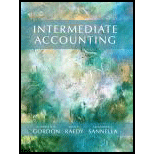
a.
The criteria of determining the carrying value of accounts receivables.
b.
Factors influencing managerial decision in estimation of amount of collectible receivables.
c.
Percentage of trade receivables to total assets.
Given information:
Trade receivables for year 2013 are $1,424 and for year 2012 are $1,454.
Total assets for year 2013 are $15,474 and for year 2012 are $15,169.
d.
Percentage of the allowance for uncollectible accounts to total trade receivables.
Given information:
Total trade receivables for year 2013 are $1,231 and for year 2012 are $1,185.
Allowance for uncollectible accounts for year 2013 is $5 and for year 2012 is $6.
e.
Write-offs of accounts receivables.
Given information:
Opening balance of allowance is $6 and $8 for year 2013 and 2012 respectively.
Additions charged to expense are $2 and $1 for year 2013 and 2012 respectively.
Doubtful accounts charged to reserve are $3 and $3 for year 2013 and 2012 respectively.
Want to see the full answer?
Check out a sample textbook solution
Chapter 9 Solutions
Intermediate Accounting
- Calculate Jenkins' net sales for the period.arrow_forwardNeed solution. General accountingarrow_forwardTownsend Manufacturing has a predetermined overhead rate of $5 per machine hour. Last year, the company incurred $128,700 of actual manufacturing overhead cost, and the account was $4,500 over-applied. How many machine hours were used during the year?arrow_forward
- For the past 10 years, Prince Company (Prince) has owned 75,000 or 75% of the common shares of Stiff Inc. (Stiff). Elizabeth Winer owns another 20% and the other 5% are widely held. Although Prince has the controlling interest, you would never know it during the annual shareholders’ meetings. Winer keeps the board of directors on its toes by asking a lot of tough questions and continually threatening legal action if her rights as a minority shareholder are not protected. Rick Impatient owns 100% of the shares of Prince. After Prince’s latest shareholders’ meeting, he decided that Prince would offer to purchase Winer’s shares in Stiff or Prince would sell its interest in Stiff because Impatient is tired of all of the heckling from Winer. The shares of Stiff were recently trading for $50 per share. On November 13, Year 13, Prince offered to pay $54 per share to Winer for her 20% interest in Stiff. To Impatient’s surprise, Winer accepted the offer and the transaction was consummated on…arrow_forwardWhat is the amount of interest expense on July 1?arrow_forwardRedmond Industries bases its predetermined overhead rate on the estimated machine-hours for the upcoming year. Data for the most recently completed year appear below: • • Estimated machine-hours = 21,500 Estimated variable manufacturing overhead = $8.25 per machine-hour Estimated total fixed manufacturing overhead $495,000 Actual machine-hours for the year = 22,800 = What is the predetermined overhead rate for the recently completed year?arrow_forward

 AccountingAccountingISBN:9781337272094Author:WARREN, Carl S., Reeve, James M., Duchac, Jonathan E.Publisher:Cengage Learning,
AccountingAccountingISBN:9781337272094Author:WARREN, Carl S., Reeve, James M., Duchac, Jonathan E.Publisher:Cengage Learning, Accounting Information SystemsAccountingISBN:9781337619202Author:Hall, James A.Publisher:Cengage Learning,
Accounting Information SystemsAccountingISBN:9781337619202Author:Hall, James A.Publisher:Cengage Learning, Horngren's Cost Accounting: A Managerial Emphasis...AccountingISBN:9780134475585Author:Srikant M. Datar, Madhav V. RajanPublisher:PEARSON
Horngren's Cost Accounting: A Managerial Emphasis...AccountingISBN:9780134475585Author:Srikant M. Datar, Madhav V. RajanPublisher:PEARSON Intermediate AccountingAccountingISBN:9781259722660Author:J. David Spiceland, Mark W. Nelson, Wayne M ThomasPublisher:McGraw-Hill Education
Intermediate AccountingAccountingISBN:9781259722660Author:J. David Spiceland, Mark W. Nelson, Wayne M ThomasPublisher:McGraw-Hill Education Financial and Managerial AccountingAccountingISBN:9781259726705Author:John J Wild, Ken W. Shaw, Barbara Chiappetta Fundamental Accounting PrinciplesPublisher:McGraw-Hill Education
Financial and Managerial AccountingAccountingISBN:9781259726705Author:John J Wild, Ken W. Shaw, Barbara Chiappetta Fundamental Accounting PrinciplesPublisher:McGraw-Hill Education





